You must be logged in to rate content!
35 minute read
DIY - BMW E39 Oil & Filter Change (vacuum extraction method)
Compliments of bluebee @ bimmerfest.com
5-28-2009
Step-by-step DIY for a 2002 E39 (BMW 525i) vacuum extraction oil change
... UPDATED AS NEEDED - PLEASE SUGGEST IMPROVEMENTS (so others benefit) ...
TOOLS:
- 36 mm 6-point socket wrench (required to remove the oil filter housing, normal oil filter sockets are not deep enough)
- 17 mm socket wrench (if you plan on also draining oil out of the engine oil drain pan)
- Torque wrench (18 foot pounds, 25 Nm, for both the oil filter housing & the the engine oil drain plug)
- Vacuum extractor (I don't recommend my Motive Power Extractor; many successfully use the Mityvac 7201 or 7400)
- Screw-cap two-gallon clear plastic containers (for transport of the old recycled motor oil)
- Nitrile gloves and shop towels and an oil pan (if you're going to also remove the 17mm engine-oil drain plug)
Hint: Measure the length of the plastic extractor hose (just in case); see reasons why here.
PARTS:
- Oil, 6.9 quarts for the I6, 8 quarts for the V8 (Hint: Buy oil by quality, cold/hot viscosity, type, and cost, in that order, as described below.)
- Oil filter, most recommend Mahle, Mann, or Hengst (I used an STP filter but people suggested German filters instead)
- Four-inch rubber O-ring for the plastic housing (usually comes with the oil filter)
- Copper compression gasket for the 17mm drain plug (usually comes with the oil filter)
Hint: File a groove or cut at an angle the bottom of the hard plastic vacuum extraction hose that bottoms out on the engine oil pan so as to break suction.
LOCATIONS:
- Dip stick and tube (drivers side, engine compartment, top)
- Oil filter and housing (driver side, engine compartment, top)
- Oil drain plug and gasket (passenger side, bottom of engine)
Note: Extraction will likely get a quarter quart more oil out of your engine than will conventional gravity methods.
Hint: Prominently mark the 6.9 or 8 quart level on the vacuum extractor container before use.
EXTRACTION METHOD OIL CHANGE (some people say extraction alone doesn't remove sediments):
0. Everyone warms up their BMW for the oil change and then parks on level ground
1. Some check the oil level in the engine & mark the extractor tank (so you know how much you sucked out)
3. A few let the BMW cool slightly (about 5 or 10 minutes) so you won't get burned
3. Most gather shop towels around the oil filter housing (to catch drips)
4. Some mark the oil-filter-housing position relative to the engine with whiteout (some say there is a green dot)
5. Some remove the oil-filler cap (to reduce reverse suction) & visibly check for sludge inside & on the cap
6. Remove the oil dipstick (and note the level as you will expect to remove at least that much oil into your containers)
7. With a 36mm socket, remove the oil filter housing & oil filter (most oil-filter wrenches won't be deep enough)
VACUUM EXTRACTION ...
8. Clamp the vacuum extractor tube & pump the vacuum 10 or 15 strokes (about 10 inches of mercury on the Motive)
9. Place the vacuum extractor intake hose into the outside ring of the oil-filter housing
10. Release the hose clamp & suck out as much oil from the oil-filter housing as you can (about 1/2 quart)
11. Again clamp the vacuum extractor hose and pump suction (about 10 or so pumps to about 10 inches of Hg)
12. Run the vacuum extractor thin hose down the dipstick tube 'till it bottoms (about 2 1/2 feet)
13. Release the vacuum extractor hose clamp and watch motor oil slowly flow into the vacuum extractor container
14. Wait ... wait ... wait ... wait ... wait ... wait ... wait ... (15 minutes or even 30 minutes or more)
15. Check on progress; pump the hand pump another half-dozen times to encourage the slow flow
16. At some point, you hear a sucking sound for a few minutes & you see bubbles in your vacuum tubing
17. It's human nature to fiddle with the hose up and down slightly to prove to yourself all the oil is really out
18. The dirty oil in the vacuum extractor container should be close to your previously marked 6.9-quart level
19. If different, mark the highest level of dirty oil obtained (which is why you checked the oil level before starting)
20. Remove the vacuum extractor tube from the dip-stick tube & replace the oil dip stick
GRAVITY DRAINING ... (skip these steps if you're not also draining oil)
21. Chock the rear, jack the front, & place on 2 jack stands (placed at the front jackpads)
22. Place an oil pan under the 17 mm drain plug on the bottom of the engine (passenger side)
23. Remove the 17 mm drain plug & allow remaining oil (and sediments) to drip into the oil pan
24. Replace the plug's copper compression washer & torque to 18 foot pounds (25 Nm)
25. Raise the front slightly to remove the jack stands, lower the car, & remove wheel chocks
26. Pour drained oil into the vacuum extractor container for eventual recycling
27. Remove the old oil filter from the oil filter housing cap
REASSEMBLE & REFILL ...
28. Lubricate the new 0-ring with a drop or two of new motor oil
29. Remove the old rubber 0-ring from the oil filter housing cap & replace with the new (lubricated) 0-ring
30. Add about a half quart of motor oil to the outside concentric circle of the oil filter housing
31. Check that the oil filter does not have a direction (most install label side up but the E39 filter is directionless)
32. Screw the oil filter housing (along with the new oil filter attached) onto its engine mounting
33. Reattach the oil filter housing to the engine, hand tight until it bottoms out (check previous position marks)
34. With a torque wrench and 36mm socket, torque the oil filter housing to 18 foot pounds (25 Nm)
35. Pour the other half quart of motor oil into the engine via the engine oil filler hole (a funnel may be useful)
36. Pour five (5) more quarts of new motor oil into the engine oil filler hole
37. Temporarily replace the engine oil-filler cap and start the engine & run for a minute or two
38. Check for leaks and check the oil level on the dipstick (it often is just about a quart low)
39. Remove the engine oil-filler cap and top up the oil with the last quart as needed
40. Replace the engine oil-filler cap & run the engine for a few minutes to check for leaks
CLEAN & RECYCLE ...
41. Clean up and recycle the old oil (often you can just pour the old oil into a bulk recycling depot)
42. Recycle the old oil containers (most people say to remove the caps but I have no idea why)
43. If desired, send a sample of old oil to be analyzed ($20) for condition & contaminants
Note: Most install the oil filter directionally, with the brand-name writing up, facing the top of the engine.
Note: There are valid arguments whether sediments are fully removed with the extraction method.
RESET SERVICE INTERVAL LIGHT: (procedure is for 2001 and later BMW E39 models):
0. Make sure the ignition key is not in the ignition, i.e., the ignition is OFF (position 0);
1. Press and hold the trip odometer button (located to the left in the instrument cluster);
2. While holding the trip odometer button, turn the ignition key to ACCESSORY (position 1);
3. Keep the trip odometer button pressed for about 5 seconds until you see "OIL SERVICE" or "INSPECTION" with "RESET" or "RE" in the display (on vehicles with the "High" cluster, you will also see the amount of fuel in liters remaining until the next scheduled service interval);
4. Let up on the trip odometer button & then again press down on the button and hold for another 5 seconds until "RESET" or "RE" flashes;
5. While "RESET" or "RE" is flashing, let up on the trip odometer button and press it down briefly to reset the service interval indicator (SII);
6. If successful, after the display has shown the new service interval, "END SIA" will appear in the display for approximately 2 seconds.
Note: If "RESET" or "RE" does not flash, then you have not met the minimum fuel consumption level and resetting is not needed (nor is it possible).
MOTOR OIL (Choose motor oil by (a) quality, (b) cold start, (c) viscosity, (d) type, & (e) cost (in that order) - never by brand or hype!):
a) QUALITY: Perhaps the most contentious of oil-selection issues shouldn't be an issue, because quality selection is (almost) as simple as reading the can.
- The problem is BMW specifies BMW LL-01 rated oil for most BMWs like mine (or LL04 which exceeds BMW LL-01 specifications) which is listed on the can of very few motor oils readily available in the USA (e.g., the only Mobil-1 that is approved is the Mobil1 SAE 0w40 variety; and you might be able to find German-made Castrol Syntec SAE 0w30 European Formula if you're resourceful, or even Pentospeed SAE 0W30, or Pennzoil Platinum European Formula Ultra SAE 5W-30, or Valvoline SynPower SAE 5W-30, etc. For more choices, please see the attached document listing the available LL-01/LL-04 motor oils available for sale in the USA.) Strictly speaking, LL-01/LL-04 is all you need to know about quality (unless you can't find LL-01/LL-04 rated oil easily). Never assume a brand name automatically equates to the desired quality. It doesn't. Never did. Never will.
- If you can't find LL-01 (or LL-04) rated oil, then some will tell you any fully synthetic oil rated ACEA A3/B3 or better meets BMW specifications; but again, the problem is finding an oil locally available that has ACEA A3/B3 printed on the can.
- Otherwise, historically, at least in the United States, the main reliable measure of quality has been the American Petroleum Institute (API) "Service" rating (buy API SL for older BMWs or API SM or better for newer BMWs) printed on every can of oil sold in the US. This more readily available API quality designation is chronological, i.e., SA, SB, SC, SD, SE, SF, SG, SH, SI, SJ, SK, SL, & SM. Over time, this API quality designation moved higher and higher in the alphabet as more and more problems are specified and overcome by the petroleum engineers (note SA is unspecified, and note each specification exceeds the prior specification).
- Note that anyone who says "use Castrol" or "get Mobil1", without suggesting the BMW or ACEA or API quality rating, isn't providing enough information to make the right quality decision for you; brand and price and label hype are meaningless for this purpose (for example, even some BMW-branded oils don't meet BMW specifications for M cars).
b) COLD START: Depending on where you live, get an appropriate Society of Automotive Engineers (SAE) winter (W) rating. Bear in mind, the SAE W rating only holds true for the first few minutes no matter what climate you live in. This rating is probably the least understood of all the motor oil descriptors, but, since most wear occurs at startup, it's an important measure. Since engine oil viscosity decreases logarithmically with temperature, the SAW W rating of, say "SAE 10W", tells you that the oil "acts like" a straight SAE 10 weight oil would act at 0 degrees Fahrenheit (F). The point is that it is NEVER an SAE 10 weight oil; it just acts like an SAE 10 would at 0 degrees F (the point is before the engine is warmed up). After the engine is warm (212 degrees F) the SAE W rating is meaningless. It is important to understand that a straight 30 weight oil acts exactly the same at engine temperatures as does a 5W30, or 10W30, or 15W30 motor oil. It is also important to understand the logarithmic decrease in viscosity still applies at all temperatures below 212 F, even though the only listed temperature is the 0 degrees F W rating. See included charts for more details.
c) VISCOSITY: Depending on engine factors, you'll choose a warmed-up SAE oil viscosity (measured as kinematic or Saybolt) that suits you and your engine. Just pick a warmed-up viscosity that your owners manual lists as an option. That's pretty much it. People make a much bigger issue of selecting the warmed-up viscosity than they need to. In my humble opinion, if you don't already know, before you got here, exactly which warmed-up viscosity you prefer, then simply choose the warmed-up viscosity by one of the other factors below this one in the selection criteria. Bear in mind, it is reputed the greater the spread between the SAE W rating and the SAE warmed-up rating (measured at 212° F), the greater the tendency of the oil to carbonize in your engine. If that is true, the simplest advice is to lean toward the closest multi-weight spread listed in your owners manual.
d) TYPE: Almost all BMW posters recommended synthetic motor oil for longevity, reduced wear and tear on gears, reduced incidence of oil oxidation, and lower sludge formation (as compared with similar quality traditional motor oils); but there are always tradeoffs, not the least of which are price considerations.
e) COST: Duh. As low as you can get. Buy Internet. Buy bulk. Stock ahead. If you buy good-quality (as measured by the API or BMW rating) oil, brand is nearly meaningless (see Consumer Reports' canonical diatribe on motor oil quality consistency over time).
Note: There is a LOT more to say about motor oils, e.g., see this from TheStig; or listen to Andrew-Debbie who tell us, among other things, "Many M cars specify Castrol TWS 10W-60" & "BMW-branded oil is probably re-branded German Castrol" Syntec 0W-30 European Formula & that other grades of Castrol easily found in the US may not meet BMW LL-01 specifications.
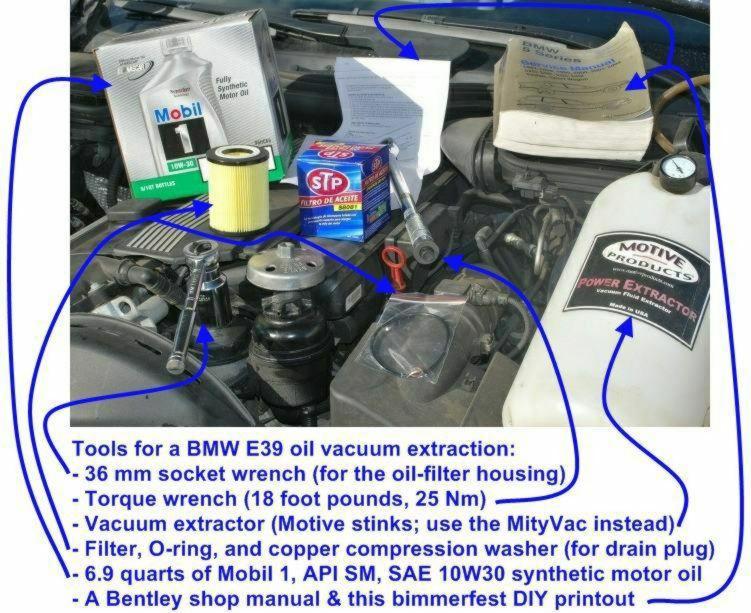
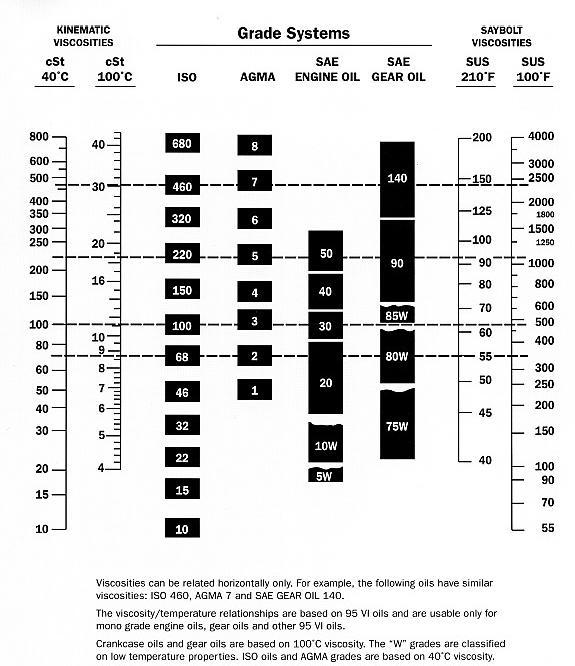
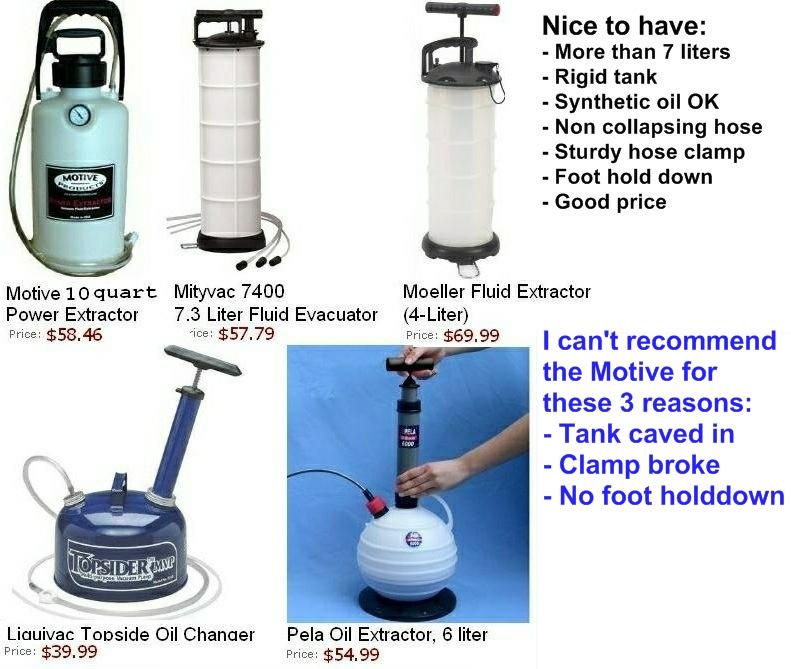
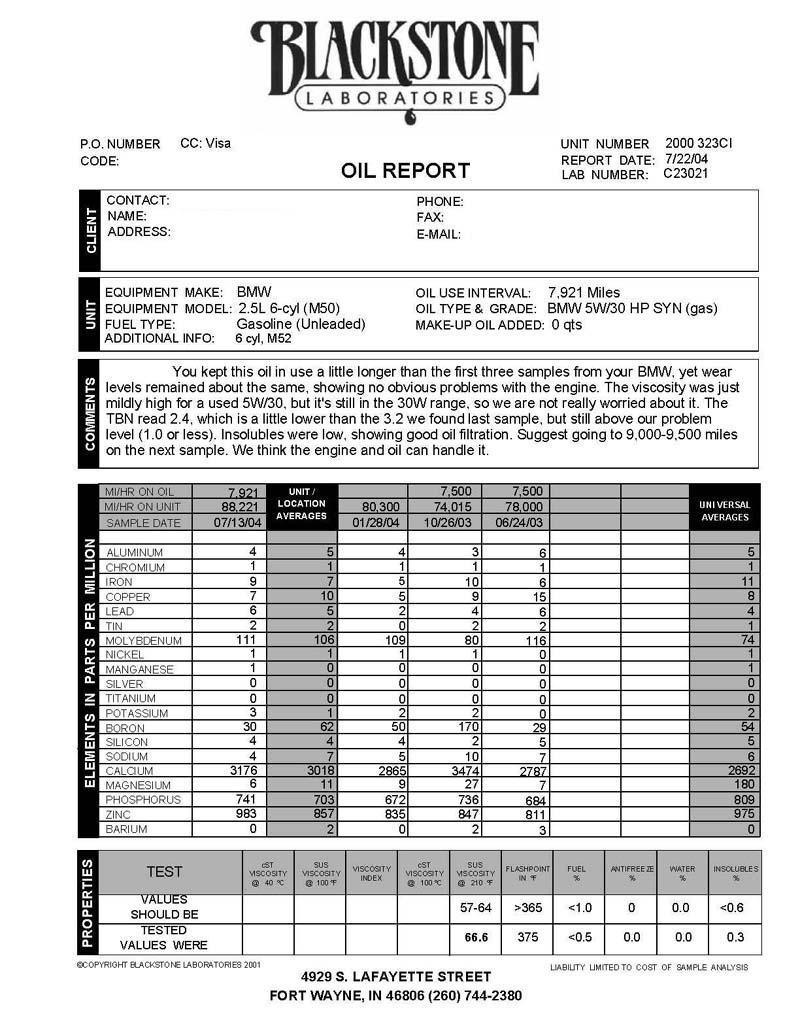
Note: Previously I had almost given up on vacuum extraction ... after my first fiasco with the Motive Power Extractor); but now, even though I can no longer recommend the Motive, I can recommend vacuum extraction overall.
6-12-2009
I understand. To begin to minimize wear at startup, we would need the viscosity rating for ambient temperature (assuming a 'cold' engine).
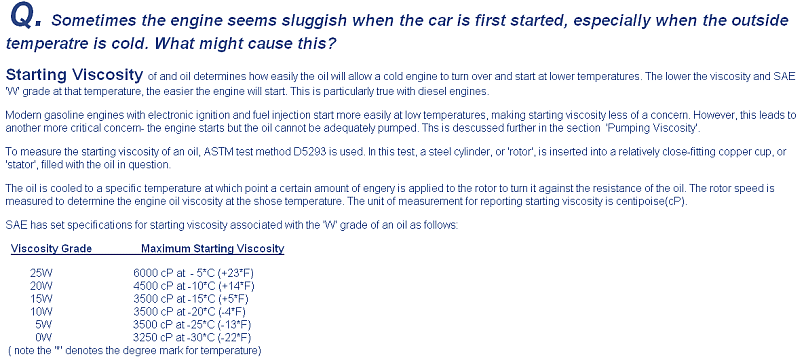
6-14-2009
I had to destroy the old oil filter in order to remove it
I had to destroy the old oil filter in order to get it off the filter housing cap. It had been on only for a few months but it seemed stuck like it was glued on permanently.
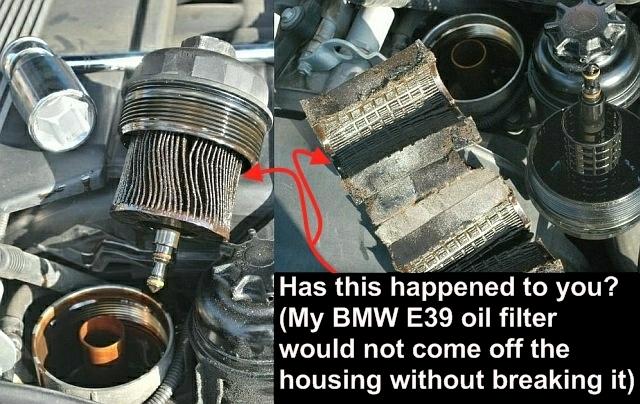
Likewise, does your Motive power extractor cave in at only ten or so pumps of the handle (only about 10 inches of Hg on the dial)?
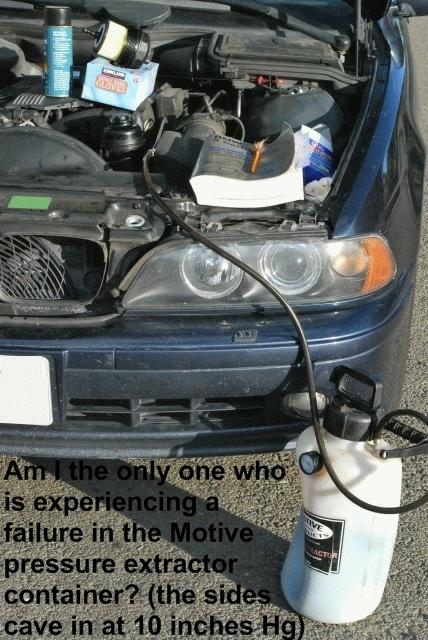
A "normal" oil-filter wrench is not deep enough for a BMW
Another problem I wonder if others run into is that I had to run out to buy a 36 mm socket because my oil-filter wrench wasn't deep enough to accommodate the height of the oil-filter housing cap.
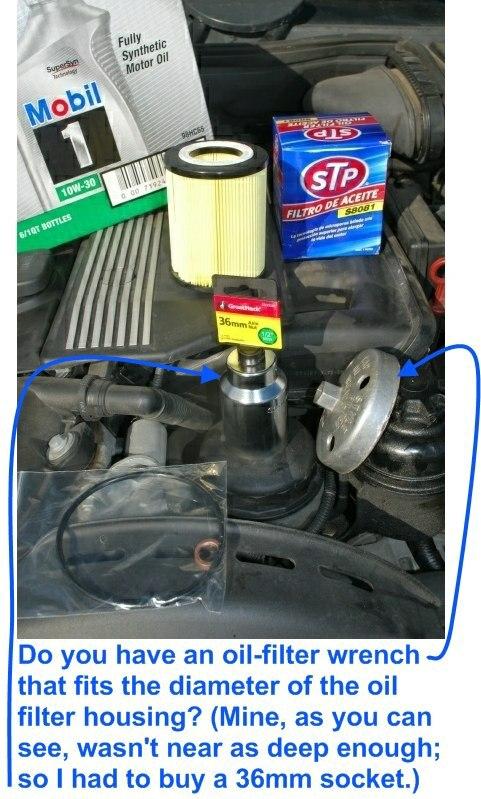
I just did a quick survey of vacuum extractors. I see of the main ones I've found, only the Motive doesn't have steel or reinforcing bars of plastic to prevent the tank from caving in.
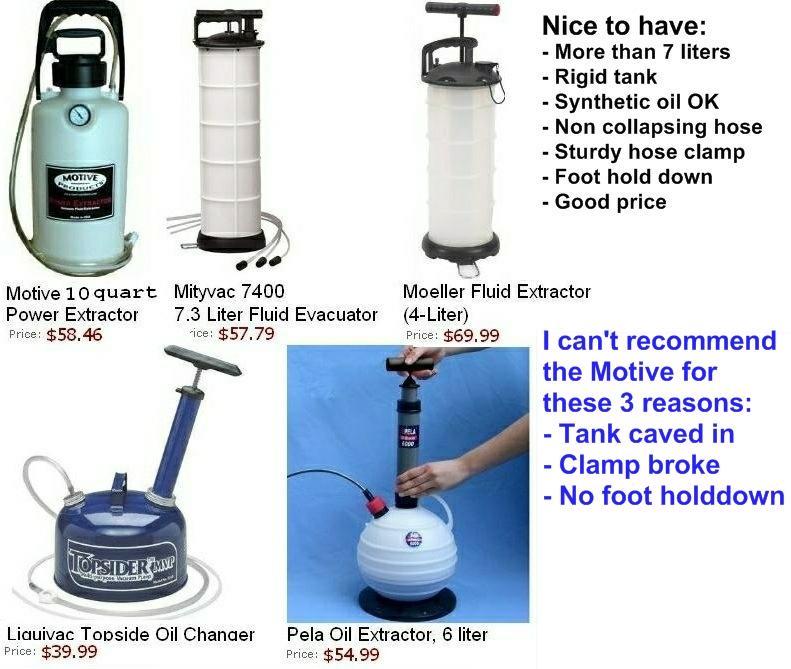
Dunno. An indy did the job. Maybe I should do my own oil changes from now on so I know what is going in there.
I pushed, I tugged, I pulled, I twisted ... but the thing was glued on solid. Luckily, cracking the old filter in pieces was trivial so it's not a big deal. I was just wondering if others have this problem at times.
BTW, the new filter I put in just now is an STP filter, mainly because I had no way of knowing what the difference was between the STP, Fram, and other oil filters available - so I went with the least expensive. The golden rule applies that, if you can't tell, and if you don't know any better, either take the time to find out (best)... or just go with the least expensive (logical).
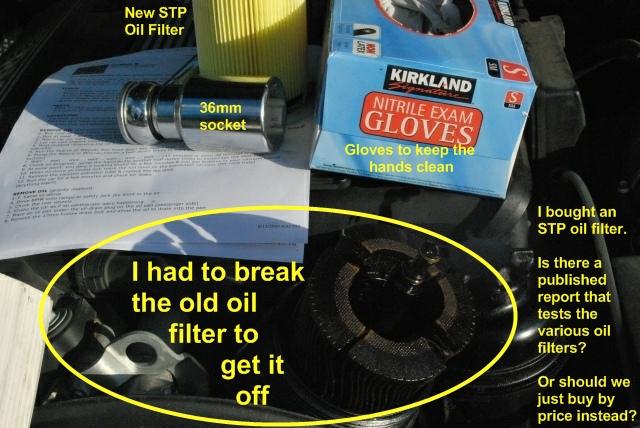
I picked up a couple of Hengst spares ... but I really need to look up how to tell the difference between a good filter and a better filter since price is not a reliable indication of quality.
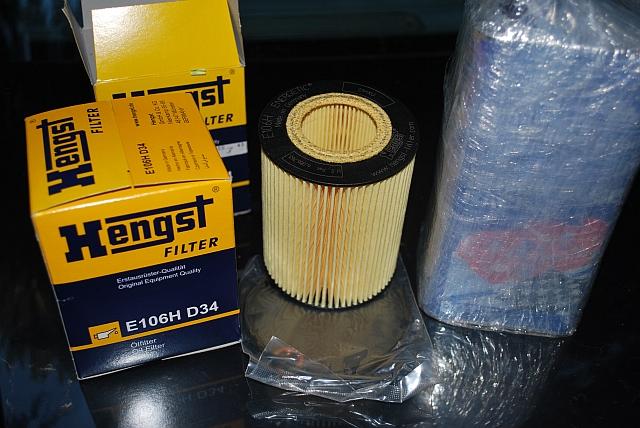
This hint came from a fellow BMW owner to file a groove in the end of the rigid hose that goes into the dipstick.
The goal is to prevent accidental suction at the very bottom of the oil pan when all the oil is out.
If this groove actually works, the theory is that it will start to suck air when all the oil is out of the engine.
Otherwise, the theory goes, it could mimic that there is more oil due to accidental suction on the bottom of the oil pan.
Does this groove look like it will work?
Seems like a good idea so I added it into the DIY so that our BMW E39 oil change DIY on this thread has everything you need to know to vacuum extract your oil.
\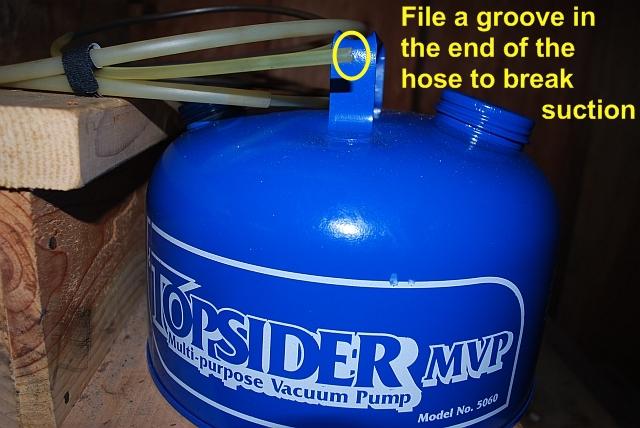
6-15-2009
What type of clamp do you use on your flexible hose?
One other thing that got me was the flimsy plastic clamp broke on the Motive Power Extractor.
Where would you suggest I get a clamp that works better?
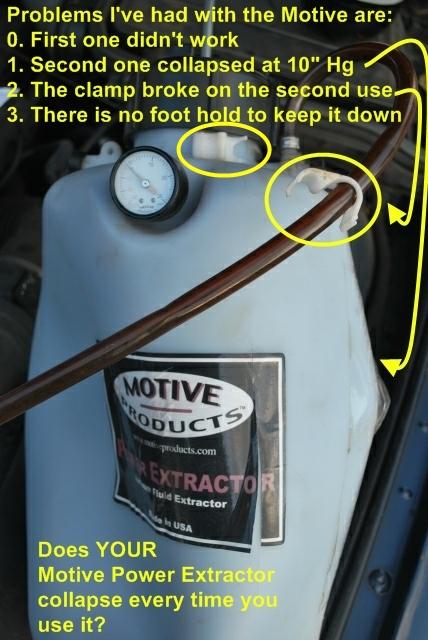
I have a separate (much smaller) pressure bleeder for brake fluid.
And a tiny vacuum bleeder (which I've never used).
Seems to me I wouldn't want a container that large for brake fluids anyway; nor would I wish to mix brake fluid with motor oil residue (and vice versa).
So, personally, I prefer to keep my pressure bleeder (brake fluid) separate from my vacuum extractor (oil).
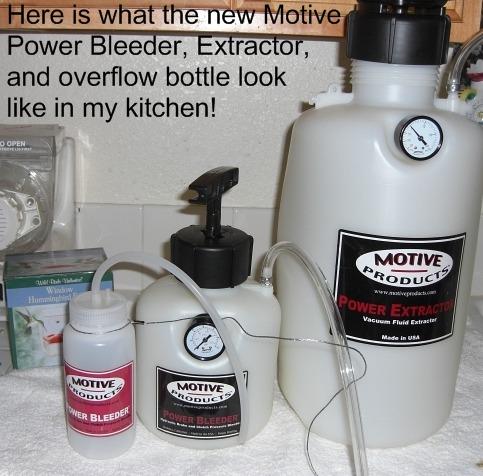
6-16-2009
Wonderful idea. Others suggest the same thing (e.g., here).
Therefore, I duly added that suggestion to the DIY post since I can still edit it. That way the vacuum extraction DIY has everything in a single post that you guys recommend or suggest!
I do see that the topsider has the same flimsy clamp as does the Motive. Has your clamp been working for 12 years? Or did you have to replace it (mine broke almost instantly when I used it).
Now that I need it, does anyone have a suggestion for a better (more sturdy) replacement clamp now that mine is snapped in half?
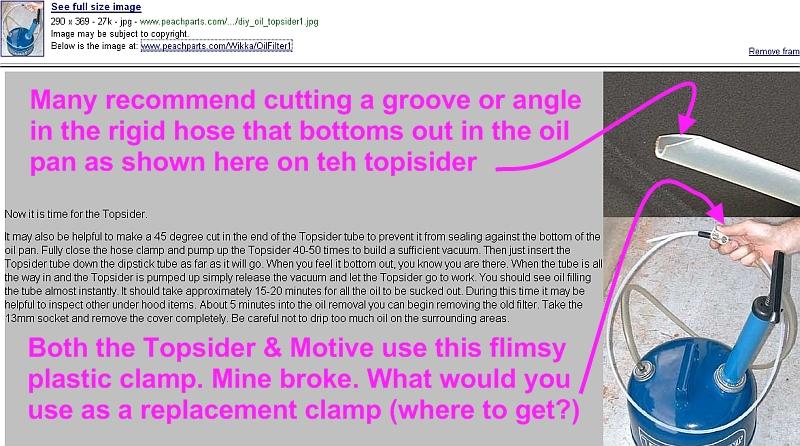
6-18-2009
Sometimes little things are important ...
Besides the oil filter having a direction in the mini video ... did you guys notice also that the guy in the video actually REMOVED the sieve and spring?
Like the oil filter having a direction, nobody tells me these things.
Mine has the sieve. Do you guys remove it also or do you leave the sieve attached to the oil housing cover when you put the filter back on?
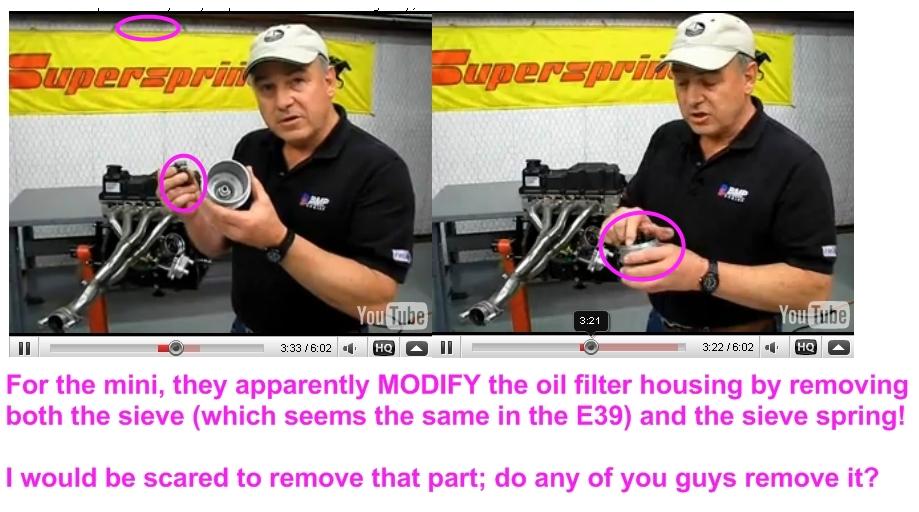
6-19-2009
Hmmm... so I put the "wrong" oil into my car (from BMW's standpoint, I guess).
What does that, mean realistically, to my engine?
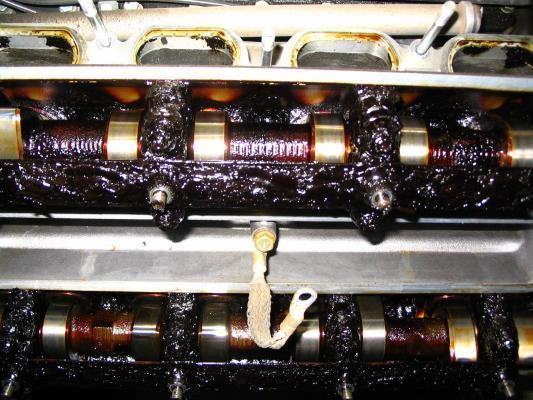
6-20-2009
I have no idea ... but, I would bear in mind ...
0. BMW goes to the trouble to mold the torque figure right on the housing;
1. The E39 oil-filter housing is just plastic (i.e., it's not very strong);
2. Some people use the wrong tools (channel locks, perhaps?) which (could) chew up the plastic;
3. If you use more than a six-point socket, there's additional force on just the (presumably flimsy) plastic corners;
4. Some of you guys have an innate "feel" for 18 foot pounds but there are people out there (like me) who don't;
5. Mine was VERY difficult to get off, even with the right tools, so I suspect some of you guys over zealously tighten it up pretty brutishlyl
6. But, as long as it doesn't leak when you're done, it (probably) works just fine no matter how tightly you tighten it up!
On the other hand ... it's simple enough (if you already have a torque wrench) to torque to 18 foot pounds; so, for me, that's a non issue.
And, well, those of you who know me, I often buy the right tools (unless they are horribly expensive) because they pay for themselves over time. For example, I bought my two torque wrenches when I did my 4-wheel brake job and I get to re-use them for free the rest of the time! 
So, my recommendation to you (fleshins) is to just order an inexpensive 3/8ths inch and 1/2 inch torque wrench from Harbor Freight and you'll get to use it on all your future DIYs.
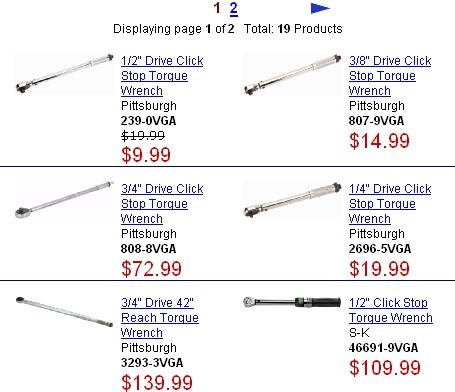
PS: I had no idea what the accuracy difference is between the inexpensive and expensive torque wrenches so others will have to advise you as to which one to purchase. Whenever I don't know the difference, I generally go with the inexpensive one and learn by using it
6-20-2009
It's too easy to recycle the motor oil and filter in California
I see we're in the same town. Yup. I poured my oil into Costco two-gallon olive-oil clear plastic screw-top containers and they picked it up right away. There was no need to travel to a collection site.
Like you, they even left me two empty plastic screw-top milk containers (which I promptly threw back into the recycle bin). And, they dropped off two very sturdy foot-long plastic lockable recycling bags (for the oil filters).
Out here, in California, almost nothing goes in the trash - everything they cheerfully recycle, including recycling oil and filters. In contrast, my cousin back east says she has to practically gift wrap her recycling and leave a ten-dollar bill jutting out just to get them to take it ... so I guess the recycling culture is different in different places.
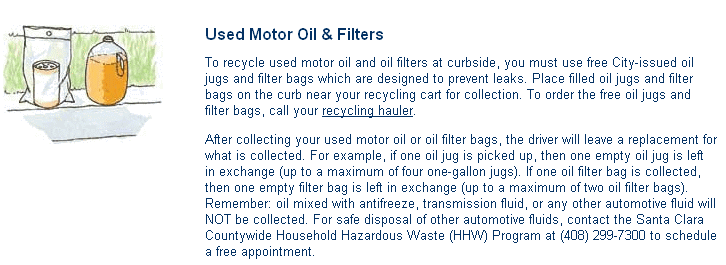
6-25-2009
I'm confused. How do you know that?
If an SAE 0W30 oil is formulated & certified (presumably at great expense and effort by the manufacturer) to act like an SAE 0 weight oil at zero degrees F and as an SAE 30 weight oil at 212 degrees F ... then how can anyone say it's anything other than that?
Likewise with the SAE 5W35 oil; how can it act "more like" an SAE 30 weight oil at 212 degrees F when the manufacturer tested it and certified that it acts like an SAE 35 weight oil at 212 degrees F?
I realize manufacturers can lie; I do understand that there are variances in batches; perhaps a BMW engine might run hotter than 212 degrees F; and I do realize any certification has a tolerance range but how would you (or I) determine the precise information you listed?
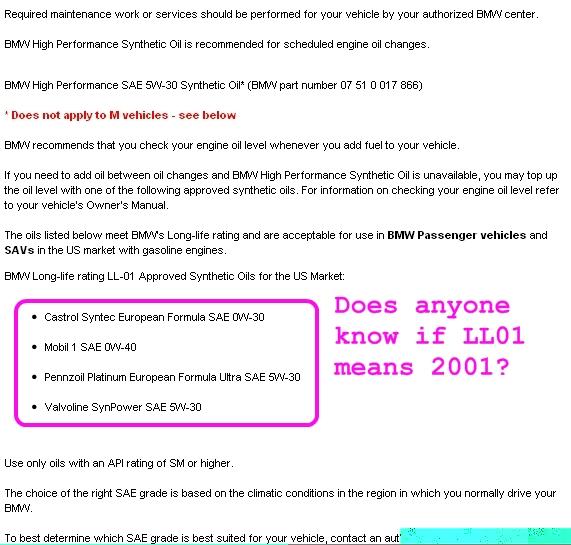
6-26-2009
Thanks for the suggestions. I just added all the datasheets and the list of all oils that meet BMW specifications to the printable DIY at the start of this thread.
This way, the first post summarizes (as best I can) what all the other posts recommend.
So far, I think I've added every suggestion; please keep 'em coming for the E39 oil-change DIY.
That way, people who start knowing almost nothing (like me), will know as much as they need to, by reading a single post!
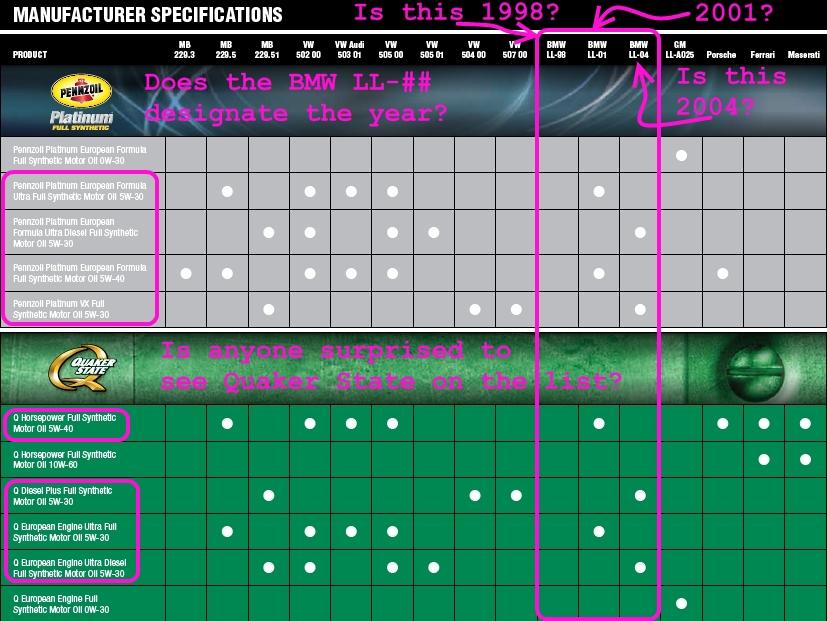
6-28-2009
BTW, my engine oil filler cap has "BMW Recommends Castrol " stamped on it.
This is strange for at least three reasons:
1) It's weird to see a blatant advertisement stamped on a non-racing engine
2) Some Castrol oils are (apparently) not BMW approved (they're not LL-01)
3) BMW-approves motor oils made by other manufacturers
Is there a good reason "BMW Recommends Castrol" is stamped on the oil-filler cover?
Are any other blatant advertisements stamped on any other part?
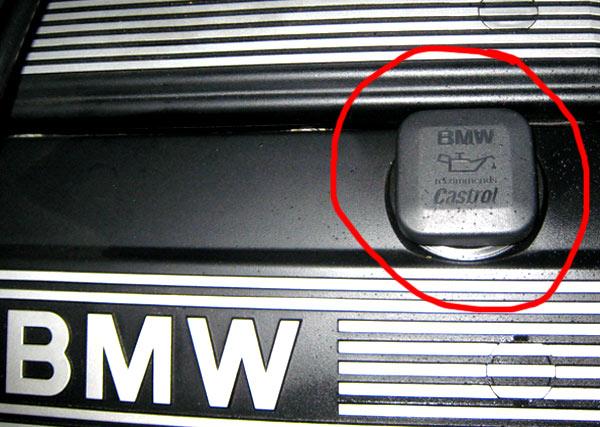
6-29-2009
There is a good recent thread on "BMW-approved oils" that explains the Castrol branding on the engine oil filler cap is more of a co-branding marketing gimmick than anything else.
For the record, that thread lists the following "BMW-approved" motor oils:
BMW Long-life rating LL-01 Approved Synthetic Oils for the US Market:
BMW High Performance SAE 5W-30 Synthetic Oil (BMW part number 07 51 0 017 866)
BMW Long-life rating LL-01 Approved Synthetic Oils for the US Market:
* Castrol Syntec European Formula SAE 0W-30
* Mobil 1 SAE 0W-40
* Pennzoil Platinum European Formula Ultra SAE 5W-30
* Valvoline SynPower SAE 5W-30
Here is a list of other LL-01 rated oils. (many are not in the US market)
Tradename-------------Viscosity----------Manufacturer/Supplier
ADDINOL Super power MV 0537 SAE 5W-30 Addinol Lube Oil GmbH
Agip Formula LL B 01 SAE 0W-30 ENI S.p.A.Refining and Marketing Division
Agip Sint 2000 Evolution SAE 5W-40 ENI S.p.A.Refining and Marketing Division
Agip TECSINT SL SAE 5W-40 ENI S.p.A.Refining and Marketing Division
Aral SuperTronic SAE 5W-30 Aral
AXCL S-Class Motor Oil SAE 0W-30 AXCL Gulf FZE
Visco 7000 SAE 0W-40 BP Oil International
BP Visco 7000 Special SAE 0W-30 BP Oil International
BP Visco 7000 SAE 0W-40 BP Oil International
SBS 5.0 "Longlife-01" BMW AG - TIS 26.12.2004 21:36Formula SLX LL01 SAE 0W-30 Castrol Limited
Castrol Formula SLX Turbo Diesel SAE 0W-30 Castrol Limited
Castrol Formula RS Power and Protection SAE 0W-40 Castrol Limited
Castrol Syntec SAE 0W-30 Castrol Limited
Castrol Super Racing 0W-40 SAE 0W-40 Castrol Limited
Castrol TXT Softec LL01 SAE 5W-30 Castrol Limited
Cepsa Star Mega Synthetic SAE 0W-30 Cepsa Lubricantes S.A.
Elf Excellium LDX SAE 0W-30 Total
Formula Ultra AB SAE 5W-30 Shell International Petroleum Company
Gulf Formula TLX SAE 0W-30 Total
Havoline Synthetic BM SAE 0W-30 Texaco
Igol Process Compact P SAE 5W-30 Igol France S.A.
Jet Top Level SAE 0W-40 ConocoPhillips GmbH
Labo RC SAE 0W-30 Fuchs Labo S.A.
Liqui Moly Longlife High Tech SAE 5W-30 Liqui Moly
megol Motorenöl New Generation SAE 5W-30 Meguin GmbH
Mobil 1 SAE 0W-40 ExxonMobil
Mobil 1 Turbo Diesel SAE 0W-40 ExxonMobil
Motorex Profile B-XL SAE 0W-30 Bucher AG
Motorex Select SP-X SAE 5W-30 Bucher AG
Motul Specific LL-01 SAE 5W-30 Motul S.A:
OMV full syn plus SAE 5W-30 OMV AG
Pennzoil European Formula Ultra SAE 5W-30 Pennzoil Quaker State
Pentospeed 0W-30 VS* SAE 0W-30 Deutsche Pentosin-Werke
Petronas Syntium 3000 LL SAE 5W-30 Petronas
Q8 Formula Special SAE 0W-30 Kuwait Petroleum
Quaker State European Formula Ultra SAE 5W-30 Pennzoil Quaker State
Satoil LazerWay B SAE 5W-30 Svenska Statoil AB
Shell Helix Ultra AB SAE 5W-30 Shell International Petroleum Company
Titan Supersyn SL SAE 0W-30 Fuchs Petrolub AG
Valvoline SynPower MXL SAE 0W-30 Valvoline
Veedol Powertron LL01 SAE 5W-30 Veedol International
Veedol Syntron SAE 0W-30 Veedol International
Wintershall VIVA 1 Longlife SAE 5W-30 SRS Schmierstoff Vertrieb GmbH
Yacco VX 1600 SAE 5W-30 Yacco S.A.S.
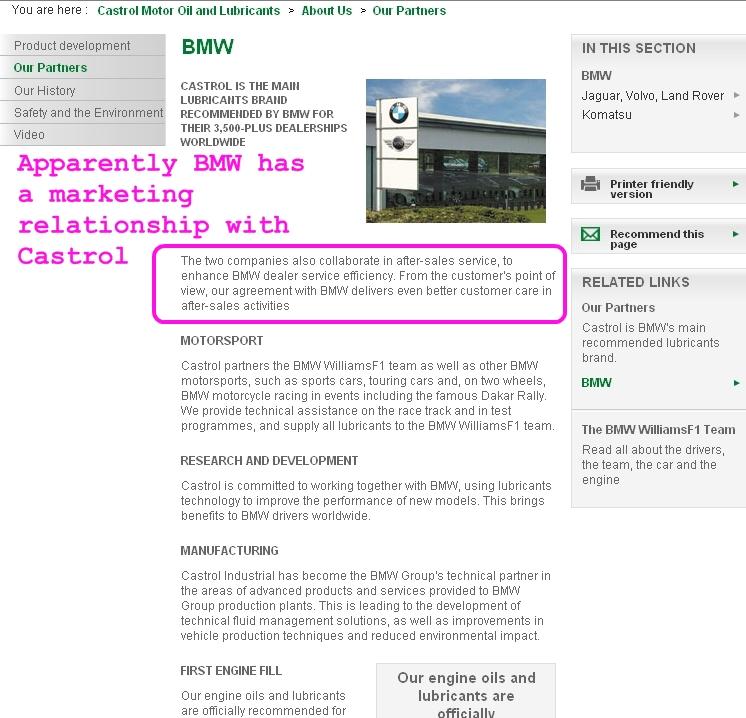
7-21-2009
For the record ...
Saw some good advice for WHEN to change your oil (based on the green bars interpretation) in this post today ... which says
"The 5 green "blocks" that tells you its time to service ... It tries to guess how hard you drive your engine ... My 5 lights will usually go after 10-12k miles, and I change oil every 2 lights or 7500 miles - whatever comes first. I just figured that I will change my oil twice as frequently as BMW advise."
And, also saw today another tidbit which we didn't cover (I can't edit the original oil-change DIY anymore) which is to check the gasket in the oil filler cap for leaks during each oil change.
8-13-2009
This thread is worth cross referencing 'cuz apparently it's a great place to get both the Mann and Mahle oil filters cheap online for your next oil change.
BTW, here is a motor oil myths-and-facts reference that backs up my (otherwise unsubstantiated) claim that you should strive to keep the cold-hot viscosity spread as close as possible.
There is no free lunch.
You can't have everything in all conditions.
The greater the viscosity spread, the less the actual motor oil (per volume) and the greater the (rare) chance of increased deposits.
Reducing hot/cold viscosity spread is one selection criterion very few people consider ... which is why I belabor the issue here.
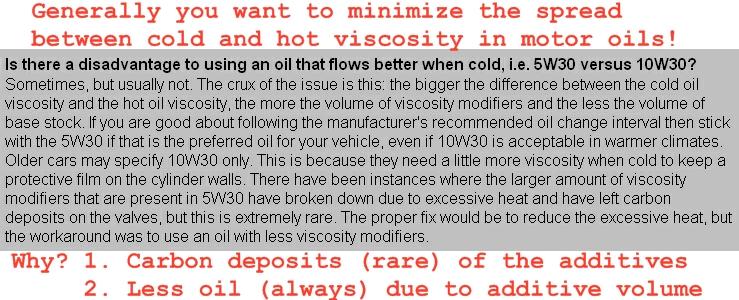
9-3-2009
Interestingly, I can't find a reference that both discusses the tradeoffs of viscosity modifiers and makes a distinction between dino juice and synthetics.
In searching, I found this article which suggests the viscosity index improvers are the first things to break down in a wide-spread multiweight oil ...
I heard what you said (that there is less of a need for the viscosity index improvers in synthetics) ... I'm just trying to find a reference that backs up that claim (for wide-spread oils such as Mobil 1 0W40 for example).

Still looking for a reference that says there are or are no tradeoffs associated with a wide viscosity spread in synthetics (versus dino juice), I did find the maximum spread possible in this article (even for synthetics, it seems)...
It seems a 0W50 weight oil (synthetic or not) is impracticable, as is 0W60 ... which backs up my otherwise unsubstantiated hypothesis that the wide viscosity spread of the Mobil 1 0W40 synthetic isn't without its tradeoffs.
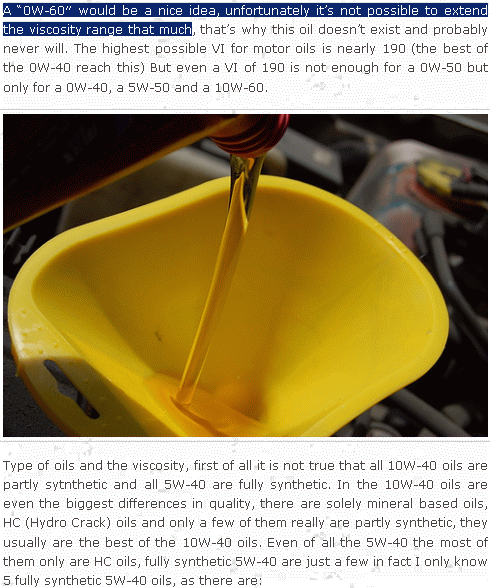
9-8-2009
Agreed. I recommend buying first by (a) quality, (b) cold start, (c) viscosity, (d) type, & (e) cost (in that order).
Notice that 'type' is a fourth-order consideration, just above total costs. Sure, synthetic is slippery and lasts longer & doesn't break down as easily; but it also costs more and you can always change your dino juice more often for a cost-effective similar result (over 150K miles or so).
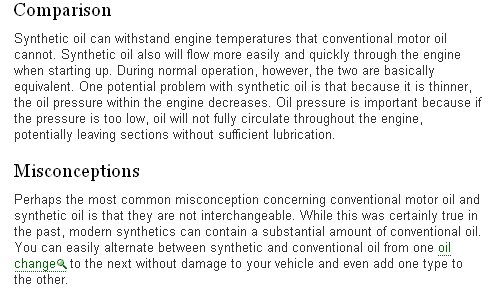
9-16-2009
QSilver kindly posted these nice oil-service-interval reset instructions with additional information which I'm cross referencing here for others to benefit.
I suggest printing this below and keeping it in your glove compartment or Bentleys for future use.
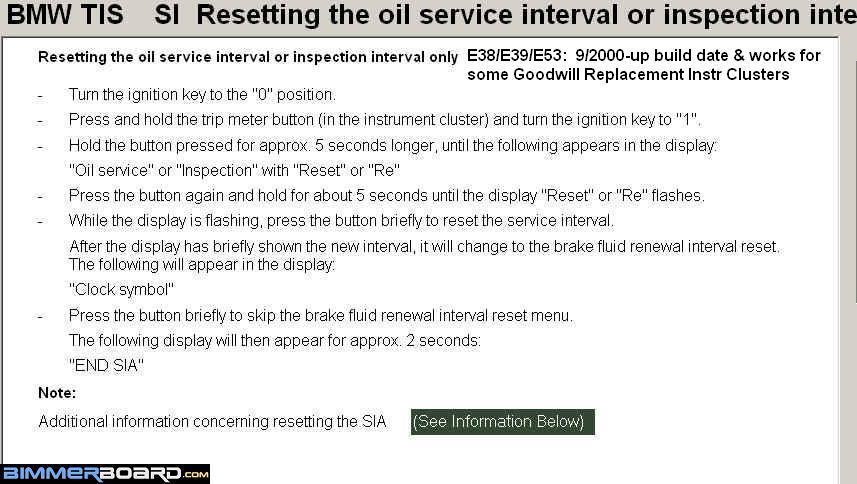
Ooops. Here's the additional information ...
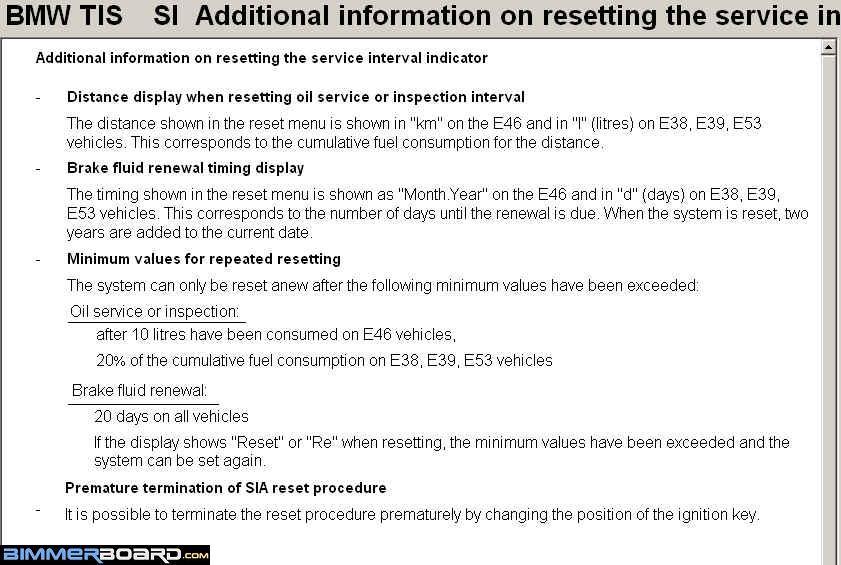
And, this xref is a nice diagram from here ...
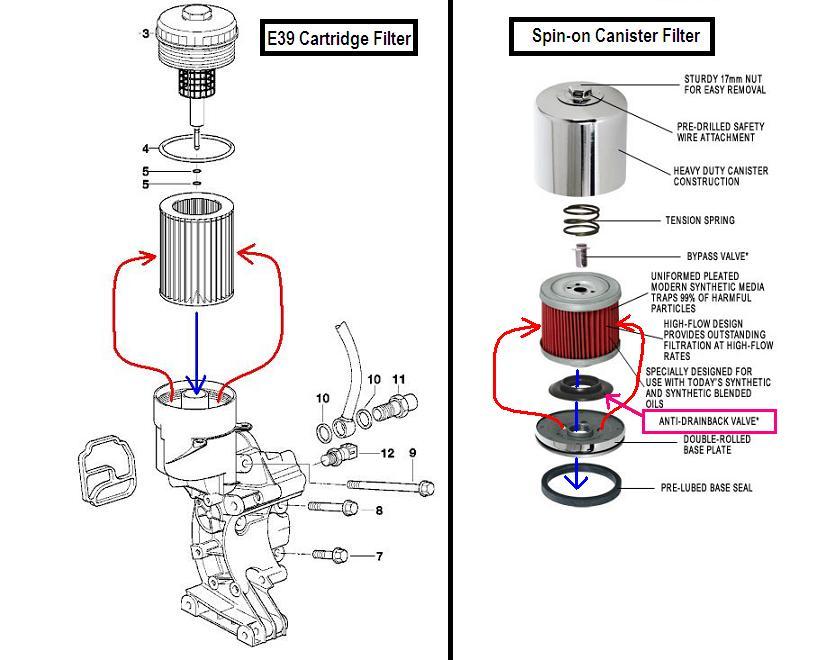
11-24-2009
Nice balanced thread on the topic of wide weight viscosities here with references here and there ...
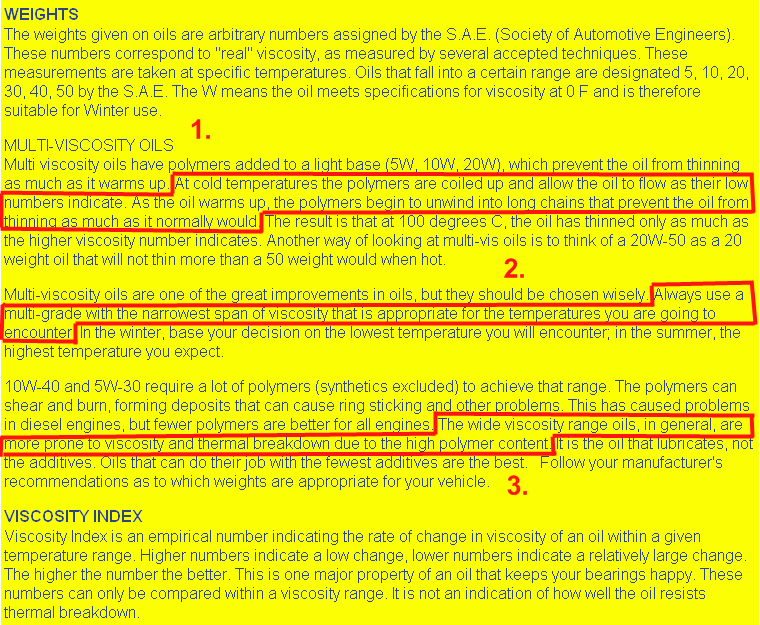
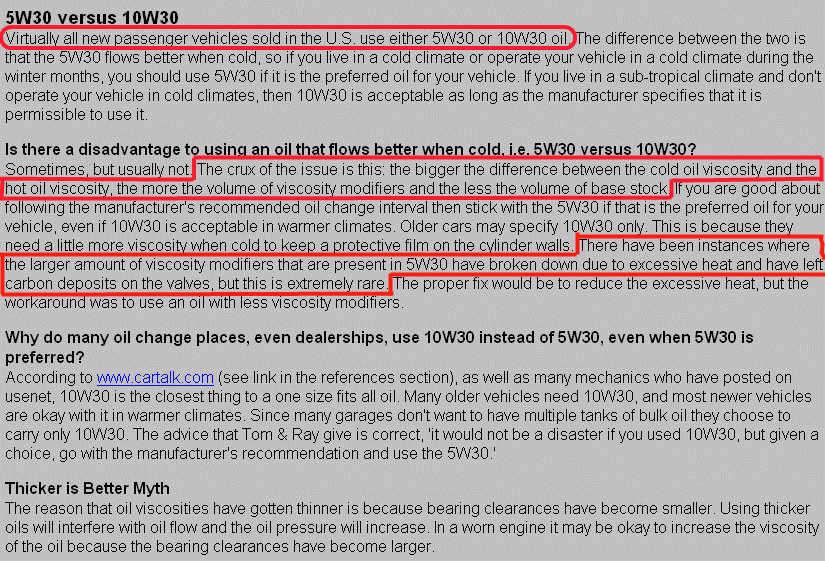
2-2-2010
For the record, even though it's for a 740iL, there is a nice DIY on changing your oil here ...
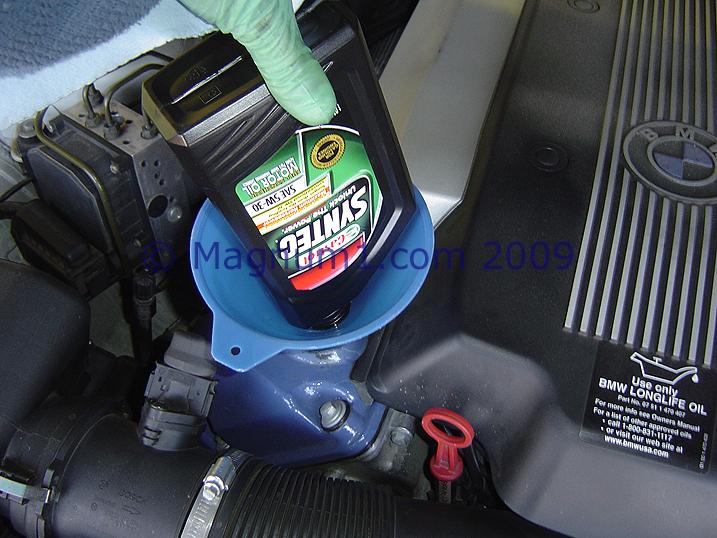
2-7-2010
I updated the picture summary (see below).
Also reference nice diagrams in this oil thread.
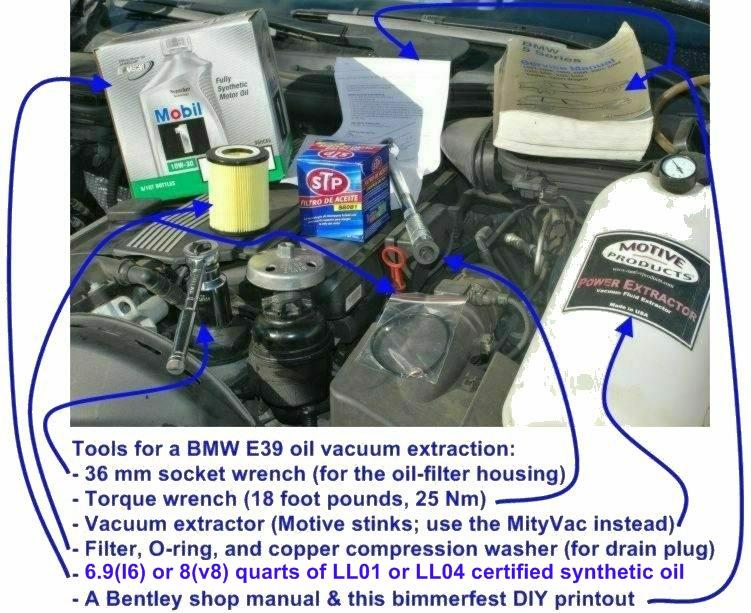
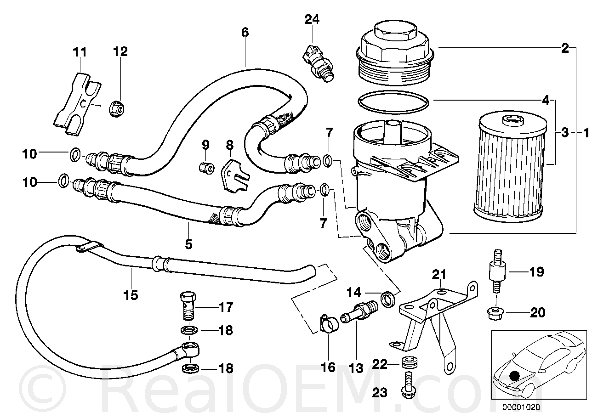
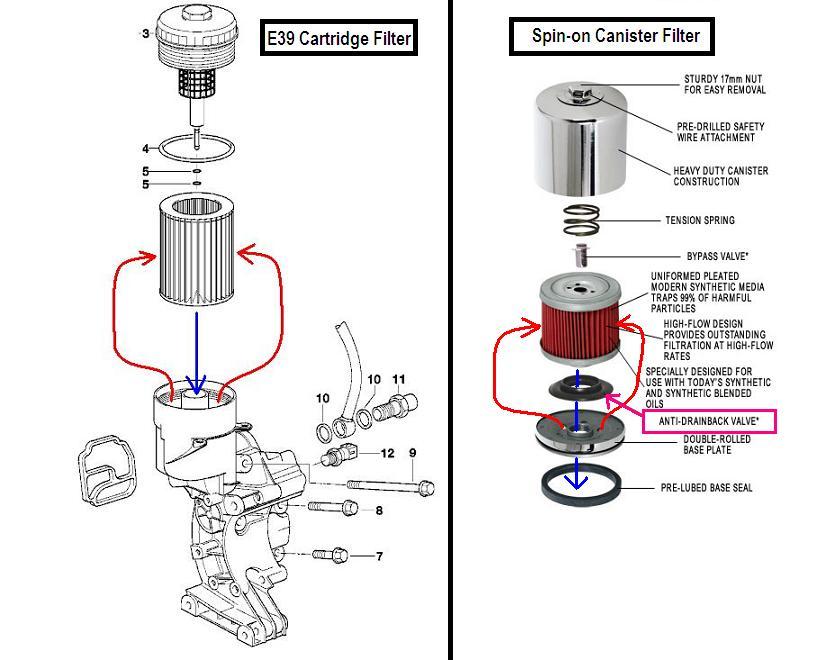
5-4-2010
Choose motor oil by quality, cold-start, viscosity, type, and cost (not by brand!)
Update: 540M-Sport kindly pointed out some inaccuracies in my criteria for selecting oil for the E39 in this post. I left out some of his recommendations (because I don't believe or understand them ... so for more, go to that post for details).
In the interest of helping people choose motor oil for their E39, I will fix the recommendation in a subsequent thread but can't do it to the original post so I just point it out here.
Choose motor oil by:
(a) quality,
(b) cold start,
(c) viscosity,
(d) type, &
(e) cost (in that order)
Never by brand!
a) QUALITY: Perhaps the most contentious of oil-selection issues shouldn't be an issue at all, because quality selection is (almost) as simple as reading the can. The can should have the BMW Long-Life 2001 approval stamp:
- BMW LL-01 Approved (not "recommended for LL01" applications).
Note (thanks to 540M-Sport): LL-04 (long life 2004) spec oils are NOT recommended for BMW's with gasoline engines in North America. From BimmerFile.com "What we can tell you now is that for most newer gasoline BMW models in the US the required oil must meet BMW LL-01 (approved not recommended for) specifications. There is further confusion because BMW LL-04 is recommended in gasoline and diesel engines for most other countries. In the US it will be required only for the new Advanced Diesels. The issue with the LL-04 oil in the US is that even though the sulfur content in gasoline has decreased in the US it is still not consistent. The inconsistency in levels makes the LL-04 oils not recommended in the US gasoline engines. Since the new sulfur requirements of diesel in the US require consistent levels LL-04 can be utilized in these applications."
The problem is BMW LL-01 approved oil is listed on the can of very few motor oils readily available in the USA (e.g., the only Mobil-1 that is approved is the Mobil1 SAE 0w40 variety; and you might be able to find German-made Castrol Syntec SAE 0w30 European Formula if you're resourceful, or even Pentospeed SAE 0W30, or Pennzoil Platinum European Formula Ultra SAE 5W-30, or Valvoline SynPower SAE 5W-30, etc. For more choices, please see this document listing the available LL-01/LL-04 motor oils available for sale in the USA.)
Strictly speaking, in the USA, for E39s, LL-01 is all you need to know about quality. Never assume a brand name automatically equates to the desired quality. It doesn't. Never did. Never will. Not all Mobil1 oils are LL-01 approved, for example.
- If you can't find LL-01 rated oil, then some will tell you any fully synthetic oil rated ACEA A3/B3 or better meets BMW specifications; but again, the problem is finding an oil locally available that has ACEA A3/B3 printed on the can.
- Otherwise, historically, at least in the United States, the main reliable measure of quality has been the American Petroleum Institute (API) "Service" rating (buy API SL for older BMWs or API SM or better for newer BMWs) printed on every can of oil sold in the US. This more readily available API quality designation is chronological, i.e., SA, SB, SC, SD, SE, SF, SG, SH, SI, SJ, SK, SL, & SM. Over time, this API quality designation moved higher and higher in the alphabet as more and more problems are specified and overcome by the petroleum engineers (note SA is special in that it is unspecified, and note each specification exceeds the prior specification).
- Note that anyone who says "use Castrol" or "Mobil1", without suggesting the BMW or ACEA or API quality rating, isn't providing enough information to make the right quality decision for you; brand and price and label hype are meaningless for this purpose (for example, even some BMW-branded oils don't meet BMW specifications for M cars).
b) COLD START: Depending on where you live, get an appropriate Society of Automotive Engineers (SAE) winter (W) rating. Bear in mind, the SAE W rating only holds true for the first few minutes no matter what climate you live in. This rating is probably the least understood of all motor oil descriptors, but, since most wear occurs at startup, it's an important measure. Since engine oil viscosity decreases logarithmically with temperature, the SAE W rating of, say "SAE 10W", tells you that the oil "acts like" a straight SAE 10 weight oil would act at 0° Fahrenheit (°F). Remember, it is NEVER an SAE 10 weight oil! It just acts like an SAE 10 would at 0°F (i.e., before the engine is warmed up). After the engine is warm (212°F) the SAE W rating is meaningless. It is important to understand that a straight 30 weight oil acts exactly the same at engine temperatures as does a 5W30, or 10W30, or 15W30 motor oil. It is also important to understand the logarithmic decrease in viscosity still applies at all temperatures below 212°F, even though the only listed temperature is the 0°F W rating. See included charts for more details.
c) VISCOSITY: This doesn't really matter as much as people think it does. Depending on engine factors, you'll choose a warmed-up SAE oil viscosity (measured as kinematic or Saybolt) that suits you and your engine. Just pick a warmed-up viscosity that your owners manual lists as an option. There will be more than one choice. That's pretty much it. People make a much bigger